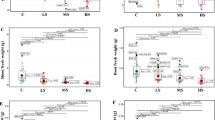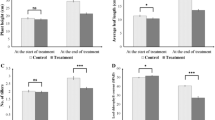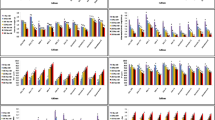Abstract
Background
Soil salinity has been affecting wheat production worldwide over past few decades. Evaluation of wheat genotypes for salinity tolerance at germination and vegetative growth level is crucial. Marker assisted selection is a technique used extensively for choosing salt-tolerant genotypes from breeding populations to introduce novel genes.
Methods and materials
The current study's main goal was to discover salt-stress resistant genes; genetic divergence and genome-wide connection by using recently designed candidate gene-based simple-sequence-repeat markers (cg-SSRs). The phenotypic connection of morphological features during the germination growth stage i.e., germination period, root length/weight and shoot length/weight, and vegetative growth stages i.e., root length/weight and shoot length/weight were tested in a group of 50 wheat genotypes. Significant difference was observed in germination rate, root length and weight among control and saline treatments.
Conclusion
Total 30 SSR markers were utilized to test salinity resistance genes in wheat genotypes. Three (10%) of which were monomorphic, one (3.34%) showed no result, and the other 26 (86%) were polymorphic. Using 30 polymorphic markers discovered total 37 alleles. The polymorphic information content (PIC), quantifies each SSR locus capacity to discriminate between wheat, varied from 0.00 to 0.38 with an average of 0.19. Association analysis revealed that 26 primers were associated with morphological features, 03 with root length and the remaining 23 with germination. Utilizing morphological data, stress tolerance index (STI) was designed concluding that Auqab-2000, Margala-99 and Ufaq showed better resistance against salinity among other wheat genotypes. Cluster analysis demonstrated that wheat genotypes have vast genetic variability.




Similar content being viewed by others
Data availability
The datasets generated during and/or analyzed during the current study are available from the corresponding author on reasonable request.
References
Agrama H, Eizenga G, Yan W (2007) Association mapping of yield and its components in rice cultivars. Mol Breed 19(4):341–356
Al-Faifi SA, Migdadi HM, Al-Doss A, Ammar MH, El-Harty EH, Khan MA, Alghamdi SS (2013) Morphological and molecular genetic variability analyses of Saudi lucerne (Medicago sativa L.) landraces. Crop Past Sci 64(2):137–146
Arshad SF, Sadia B, Awan FS, Jaskani MJ (2017) Estimation of genetic divergence among sorghum germplasm of Pakistan through multivariate tools. IJAB 19:1099–1106
Bhandal IS, Malik C (1988) Potassium estimation, uptake, and its role in the physiology and metabolism of flowering plants International review of cytology. Elsevier, London
Bradbury PJ, Zhang Z, Kroon DE, Casstevens TM, Ramdoss Y, Buckler ES (2007) TASSEL: software for association mapping of complex traits in diverse samples. Bioinformatics 23(19):2633–2635
Breseghello F, Sorrells ME (2006) Association mapping of kernel size and milling quality in wheat (Triticum aestivum L.) cultivars. Genetics 172(2):1165–1177
Buu BC, Chan CY, Lang NT (2021) Molecular breeding for improving heat stress tolerance in rice: recent progress and future perspectives. Mol Breed Rice Abiotic Stress Tol Nutr Qual 2021:92–119
Chan EK, Rowe HC, Corwin JA, Joseph B, Kliebenstein DJ (2011) Combining genome-wide association mapping and transcriptional networks to identify novel genes controlling glucosinolates in Arabidopsis thaliana. PLoS Biol 9(8):e1001125
Chen X (2005) Epidemiology and control of stripe rust (Puccinia striiformis f. sp. Tritici) on wheat. Can J Plant Pathol 27(3):314–337
Drenkard E, Richter BG, Rozen S, Stutius LM, Angell NA, Mindrinos M, Ausubel FM (2000) A simple procedure for the analysis of single nucleotide polymorphisms facilitates map-based cloning in Arabidopsis. Plant Physiol 124(4):1483–1492
Du HY, Shen YZ, Huang ZJ (2013) Function of the wheat TaSIP gene in enhancing drought and salt tolerance in transgenic Arabidopsis and rice. Plant Mol Biol 81(4–5):417–429
Feiyu T, Xueqin F, Wangcheng M, Wang X, Wenjun X (2012) Performance of yield components and morphological traits and their relationships of the lint yield in Bt cotton (Gossypium hirsutum) hybrids. Int J Agric Biol 14(3):1
Filiz E, Ozdemir B, Budak F, Vogel J, Tuna M, Budak H (2009) Molecular, morphological, and cytological analysis of diverse Brachypodium distachyon inbred lines. Genome 52(10):876–890
Goudarzi M, Pakniyat H (2008) Evaluation of wheat cultivars under salinity stress based on some agronomic and physiological traits. J Agri Soc Sci 4(1):35–38
Grohme MA, Soler RF, Wink M, Frohme M (2013) Microsatellite marker discovery using single molecule real-time circular consensus sequencing on the Pacizic Biosciences RS. Biotechniques 55(5):253–256
Hartman GL, Miles MR, Frederick RD (2005) Breeding for resistance to soybean rust. Plant Dis 89(6):664–666
Khan S (2015) QTL mapping: a tool for improvement in crop plants. Res J Recent Sci 2277:2502
Kraakman A, Martinez F, Mussiraliev B, Van Eeuwijk F, Niks R (2006) Linkage disequilibrium mapping of morphological, resistance, and other agronomically relevant traits in modern spring barley cultivars. Mol Breed 17(1):41–58
Krishnasamy V, Seshu D (1990) Germination after accelerated ageing and associated characters in rice varieties. Seed Sci Technol (Switzerland) 18(1):147–156
Li Y, Huang Y, Bergelson J, Nordborg M, Borevitz JO (2010) Association mapping of local climate-sensitive quantitative trait loci in Arabidopsis thaliana. Proc Natl Acad Sci 107(49):21199–21204
Malosetti M, Van der Linden C, Vosman B, Van Eeuwijk F (2007) A mixed-model approach to association mapping using pedigree information with an illustration of resistance to Phytophthora infestans in potato. Genetics 175(2):879–889
Manmathan H, Lapitan NL (2013) Measuring germination percentage in wheat. Bio Protocol 3(16):e866–e866
Mason A (2015) Plant genotyping. Plant Genotyp Methods Protoc 2015:77–89
Mendes RE, Kiyota KA, Monteiro J, Castanheira M, Andrade SS, Gales AC, Tufik S (2007) Rapid detection and identification of metallo-β-lactamase-encoding genes by multiplex real-time PCR assay and melt curve analysis. J Clin Microbiol 45(2):544–547
Munns R, James RA, Läuchli A (2006) Approaches to increasing the salt tolerance of wheat and other cereals. J Exp Bot 57(5):1025–1043
Munns R, Tester M (2008) Mechanisms of salinity tolerance. Annu Rev Plant Biol 59:651–681
Pereira G, Nunes E, Laperuta L, Braga M, Penha H, Diniz A, Vieira M (2013) Molecular polymorphism and linkage analysis in sweet passion fruit, an outcrossing species. Ann Appl Biol 162(3):347–361
Randhawa HS, Asif M, Pozniak C, Clarke JM, Graf RJ, Fox SL, Singh AK (2013) Application of molecular markers to wheat breeding in Canada. Plant Breed 132(5):458–471
Schuerger AC, Laible PD (1994) Biocompatibility of wheat and tomato in a dual culture hydroponic system. HortScience 29(10):1164–1165
Shabbir MZ, Arshad M, Hussain B, Nadeem I, Ali S, Abbasi A, Ali Q (2014) Genotypic response of chickpea (Cicer arietinum L.) for resistance against gram pod borer (Helicoverpa armigera). Adv Life Sci 2(1):23–30
Shafi M, Bakht J, Khan MJ, Khan MA, Anwar S (2010) Effect of salinity on yield and ion accumulation of wheat genotypes. Pak J Bot 42(6):4113–4121
Shokat S, Großkinsky DK (2019) Tackling salinity in sustainable agriculture what developing countries may learn from approaches of the developed world. Sustainability 11(17):4558
Singh AK, Chaurasia S, Kumar S, Singh R, Kumari J, Yadav MC, Jacob SR (2018) Identification, analysis and development of salt responsive candidate gene based SSR markers in wheat. BMC Plant Biol 18(1):1–15
Skøt L, Humphreys MO, Armstead I, Heywood S, Skøt KP, Sanderson R, Hamilton N (2005) An association mapping approach to identify flowering time genes in natural populations of Lolium perenne (L.). Mol Breed 15(3):233–245
Song Q, Jia G, Zhu Y, Grant D, Nelson RT, Hwang EY, Cregan PB (2010) Abundance of SSR motifs and development of candidate polymorphic SSR markers (BARCSOYSSR_1.0) in soybean. Crop Sci 50(5):1950–1960
Temnykh S, DeClerck G, Lukashova A, Lipovich L, Cartinhour S, McCouch S (2001) Computational and experimental analysis of microsatellites in rice (Oryza sativa L.): frequency, length variation, transposon associations, and genetic marker potential. Genome Res 11(8):1441–1452
Yuan X, Pan J, Cai R, Guan Y, Liu L, Zhang W, Si L (2008) Genetic mapping and QTL analysis of fruit and flower related traits in cucumber (Cucumis sativus L.) using recombinant inbred lines. Euphytica 164(2):473–491
Funding
The authors declare that no funds, grants, or other support were received during the preparation of this manuscript.
Author information
Authors and Affiliations
Contributions
All authors contributed to the study conception and design. Supervision, material preparation, data collection and analysis were performed by (RK), (AS), (SB) and (GMA) respectively. The molecular work and first draft of the manuscript was done by (MK) and all authors commented on previous versions of the manuscript. All authors read and approved the final manuscript.
Corresponding author
Ethics declarations
Conflict of interest
The authors have no relevant financial or non-financial interests to disclose.
Ethical approval
This article does not contain any studies with human participants or animals performed by any of the authors.
Additional information
Publisher's Note
Springer Nature remains neutral with regard to jurisdictional claims in published maps and institutional affiliations.
Rights and permissions
Springer Nature or its licensor (e.g. a society or other partner) holds exclusive rights to this article under a publishing agreement with the author(s) or other rightsholder(s); author self-archiving of the accepted manuscript version of this article is solely governed by the terms of such publishing agreement and applicable law.
About this article
Cite this article
Khalid, M., Kausar, R., Shahzad, A. et al. Screening and validation of salt-stress responsive cg-SSR markers in wheat (Triticum aestivum L.) germplasm of Pakistan. Mol Biol Rep 50, 5931–5940 (2023). https://doi.org/10.1007/s11033-023-08519-w
Received:
Accepted:
Published:
Issue Date:
DOI: https://doi.org/10.1007/s11033-023-08519-w




